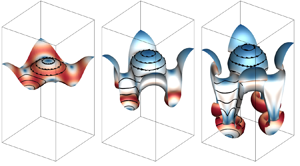Crossref Citations
This article has been cited by the following publications. This list is generated based on data provided by
Crossref.
Yu, Bin
Liu, Haoyang
and
Liu, Hong
2021.
Scaling behavior of density gradient accelerated mixing rate in shock bubble interaction.
Physical Review Fluids,
Vol. 6,
Issue. 6,
Zhou, Ye
Williams, Robin J.R.
Ramaprabhu, Praveen
Groom, Michael
Thornber, Ben
Hillier, Andrew
Mostert, Wouter
Rollin, Bertrand
Balachandar, S.
Powell, Phillip D.
Mahalov, Alex
and
Attal, N.
2021.
Rayleigh–Taylor and Richtmyer–Meshkov instabilities: A journey through scales.
Physica D: Nonlinear Phenomena,
Vol. 423,
Issue. ,
p.
132838.
Li, Xinliang
Fu, Yaowei
Yu, Changping
and
Li, Li
2021.
Statistical characteristics of turbulent mixing in spherical and cylindrical converging Richtmyer–Meshkov instabilities.
Journal of Fluid Mechanics,
Vol. 928,
Issue. ,
Dai, Jian
Xu, Fei
Cai, Xiaodong
and
Mahmoudi, Yasser
2021.
Effects of velocity shear layer on detonation propagation in a supersonic expanding combustor.
Physics of Fluids,
Vol. 33,
Issue. 10,
Peng, Naifu
Yang, Yue
and
Xiao, Zuoli
2021.
Effects of the secondary baroclinic vorticity on the energy cascade in the Richtmyer–Meshkov instability.
Journal of Fluid Mechanics,
Vol. 925,
Issue. ,
Dai, Jian
and
Peng, Linyuan
2022.
Numerical Investigation on Detonation Initiation and Propagation with a Symmetric-Jet in Supersonic Combustible Gas.
Aerospace,
Vol. 9,
Issue. 9,
p.
501.
Yu, Bin
Li, Linying
Xu, Hui
Zhang, Bin
and
Liu, Hong
2022.
Effects of Reynolds number and Schmidt number on variable density mixing in shock bubble interaction.
Acta Mechanica Sinica,
Vol. 38,
Issue. 6,
Liu, Hong
Yu, Bin
Zhang, Bin
and
Xiang, Yang
2022.
On mixing enhancement by secondary baroclinic vorticity in a shock–bubble interaction.
Journal of Fluid Mechanics,
Vol. 931,
Issue. ,
Liang, Yu
and
Luo, Xisheng
2022.
On shock-induced evolution of a gas layer with two fast/slow interfaces.
Journal of Fluid Mechanics,
Vol. 939,
Issue. ,
He, Yifeng
Peng, Naifu
Li, Haifeng
Tian, Baolin
and
Yang, Yue
2023.
Formation of the cavity on a planar interface subjected to a perturbed shock wave.
Physical Review Fluids,
Vol. 8,
Issue. 6,
Zhang, Duo
Ding, Juchun
Si, Ting
and
Luo, Xisheng
2023.
Divergent Richtmyer–Meshkov instability on a heavy gas layer.
Journal of Fluid Mechanics,
Vol. 959,
Issue. ,
Yang, Yue
Xiong, Shiying
and
Lu, Zhen
2023.
Applications of the vortex-surface field to flow visualization, modelling and simulation.
Flow,
Vol. 3,
Issue. ,
Dai, Jian
and
Liu, Jindian
2023.
Numerical study of detonation propagation under the action of supersonic pulsating flow in expanding combustor.
Acta Astronautica,
Vol. 211,
Issue. ,
p.
25.
Liu, Zhifeng
and
Yang, Yue
2023.
Construction of the vortex-surface field from tomographic particle image velocimetry data of flow past a vortex generator.
Experiments in Fluids,
Vol. 64,
Issue. 6,
Xu, Fei
Dai, Jian
Deiterding, Ralf
and
Cai, Xiaodong
2023.
Detonation stabilization in supersonic expanding channel with velocity gradients.
Physics of Fluids,
Vol. 35,
Issue. 7,
Liang, Tong
Jiang, Changzhao
Hu, Yanlei
Wang, Ziman
and
Ouyang, Lingxiang
2023.
Evolution of the gas-liquid interface dominated by Richtmyer-Meshkov instability.
International Journal of Heat and Fluid Flow,
Vol. 102,
Issue. ,
p.
109156.
Majumder, Swapnil
Sharma, Bajrang
Livescu, Daniel
and
Girimaji, Sharath S.
2023.
Compressible Rayleigh–Taylor instability subject to isochoric initial background state.
Physics of Fluids,
Vol. 35,
Issue. 9,
He, Yifeng
Meng, Baoqing
Tian, Baolin
and
Yang, Yue
2024.
Shock-induced instability of dual-layer dilute gas-particle mixture.
Physical Review Fluids,
Vol. 9,
Issue. 12,
Singh, Satyvir
and
Jalleli, Dhouha Taib
2024.
Investigation of coupling effect on the evolution of Richtmyer-Meshkov instability at double heavy square bubbles.
Science China Physics, Mechanics & Astronomy,
Vol. 67,
Issue. 1,
Zhang, Enlai
Liao, Shenfei
Zou, Liyong
Zhai, Zhigang
Liu, Jinhong
and
Li, Xinzhu
2024.
Refraction of a triple-shock configuration at planar fast–slow gas interfaces.
Journal of Fluid Mechanics,
Vol. 984,
Issue. ,
